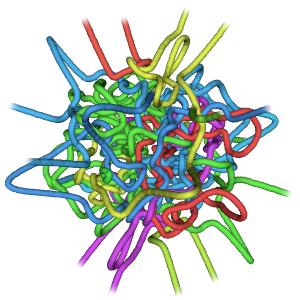Knots in chaotic waves

Tangled quantum vortices. Each vortex line is shaded in a different color, and may be knotted or linked with the others. Credit: School of Physics © University of Bristol
The computer experiments, by academics at the University of Bristol, give rise to a huge variety of different knots, realising many that have been tabulated by pure mathematicians working in the field of knot theory.
Waves surround us all the time: sound waves in the noise around us, light waves enabling us to see, and according to quantum mechanics, all matter has a wave nature. Most of these waves, however, do not resemble the regular train of waves at the shore of the ocean — the pattern is much more chaotic.
Most significantly, the whirls and eddies form lines in space called vortices. Along these lines, the wave intensity is zero, and natural wave fields – light, sound and quantum matter – are filled with a dense tangle of these null filaments.
Mark Dennis, Professor of Theoretical Physics in the School of Physics, said: “Although the computer models were framed in the language of quantum waves, these results are expected to be completely general, suggesting a new understanding of the complexity of the three-dimensional optical and acoustic landscapes that surround us every day.”
More than 40 years ago, Bristol physicians Professor Sir Michael Berry and Professor John Nye discovered vortices were originally understood to be a crucial part of wave phenomena.
This work is part of the Scientific Properties of Complex Knots (SPOCK) project, a collaboration between the Universities of Bristol and Durham. The aim of the project is to create new computational tools and mathematical techniques for the analysis, synthesis and exploitation of knotted structures in a wide range of complex physical phenomena.
The research, funded by the Leverhulme Trust, is published today in Nature Communications.
###
Paper:
'Vortex knots in tangled quantum eigenfunctions' by Alexander J Taylor and Mark R Dennis in Nature Communications
Media Contact
All latest news from the category: Physics and Astronomy
This area deals with the fundamental laws and building blocks of nature and how they interact, the properties and the behavior of matter, and research into space and time and their structures.
innovations-report provides in-depth reports and articles on subjects such as astrophysics, laser technologies, nuclear, quantum, particle and solid-state physics, nanotechnologies, planetary research and findings (Mars, Venus) and developments related to the Hubble Telescope.
Newest articles

Properties of new materials for microchips
… can now be measured well. Reseachers of Delft University of Technology demonstrated measuring performance properties of ultrathin silicon membranes. Making ever smaller and more powerful chips requires new ultrathin…

Floating solar’s potential
… to support sustainable development by addressing climate, water, and energy goals holistically. A new study published this week in Nature Energy raises the potential for floating solar photovoltaics (FPV)…

Skyrmions move at record speeds
… a step towards the computing of the future. An international research team led by scientists from the CNRS1 has discovered that the magnetic nanobubbles2 known as skyrmions can be…





















